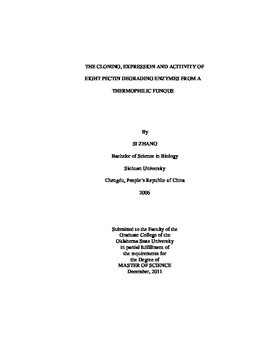| dc.contributor.author | Zhang, Si | |
| dc.date.accessioned | 2014-04-15T18:38:25Z | |
| dc.date.available | 2014-04-15T18:38:25Z | |
| dc.date.issued | 2011-12-01 | |
| dc.identifier.uri | https://hdl.handle.net/11244/8574 | |
| dc.description.abstract | e big part of biomass is in the form of plant cell walls. Fungi play an essential role in carbon and nitrogen recycling, in which one of the means is by degrading polysaccharides that human cannot utilize efficiently. To get a deeper insight into degradation of pectin, one of the major groups of plant polysaccharides six polygalacturonases, one rhamnogalacturonase, and one xylogalacturonase from a thermophilic fungus, Aspergillus niveus found widely in soil and decaying organic matter, were cloned and expressed in Aspergillus nidulans fused to a his tag. These enzymes break down different components of pectin. Their functions and activities are studied by cloning using E. coli , expression using A. nidulans , purification using Ni-NTA, and activity determination using various substrates. Western Blotting detected that the His-tag was expressed correctly. However, purification using Ni-NTA failed, indicating the His-tag was not able to bind to Ni resin. SDS-PAGE protein gels showed the actual sizes of the proteins were larger than theoretical sizes. Expression and purification studies suggested that all eight enzymes expressed in A. nidulans were probably highly glycosylated. Pectic acid was used as substrate for the six polygalacturonases; rhamnogalacturonan from citrus pectin was used for the rhamnogalacturonase and partially hydrolyzed gum tragacanth was used for the xylogalacturonase. Only one exo-polygalacturonase does not have signal peptide. Among eight enzymes, three of six polygalacturonases are exo-polygalacturonases and the others are endo-polygalacturonases. For the exo-polygalacturonases, all of them cut off one or two GalA at a time. One has some limitation on length of substrate. The specific limitation remains unknown. For the endo-polygalacturonases, all of them work in endo-style. Final products from pectic acid for one of them were GalA1-GalA4. For another they were only GalA1 and GalA2 while for the third the main products were GalA1-GalA5. For the rhamnogalacturonase, the final products were RG2 and RG3. And for the xylogalacturonase, the information about final products is unavailable at present. NMR will be performed for their identification. | |
| dc.format | application/pdf | |
| dc.language | en_US | |
| dc.publisher | Oklahoma State University | |
| dc.rights | Copyright is held by the author who has granted the Oklahoma State University Library the non-exclusive right to share this material in its institutional repository. Contact Digital Library Services at lib-dls@okstate.edu or 405-744-9161 for the permission policy on the use, reproduction or distribution of this material. | |
| dc.title | Cloning, Expression and Acitivity of Eight Pectin Degrading Enzymes from a Thermophilic Fungus | |
| dc.type | text | |
| osu.filename | Zhang_okstate_0664M_11831.pdf | |
| osu.college | Agricultural Sciences and Natural Resources | |
| osu.accesstype | Open Access | |
| dc.description.department | Department of Biochemistry and Molecular Biology | |
| dc.type.genre | Thesis | |
| dc.subject.keywords | aspergillus | |
| dc.subject.keywords | galacturonase | |
| dc.subject.keywords | pectin | |
| dc.subject.keywords | plant cell wall | |
